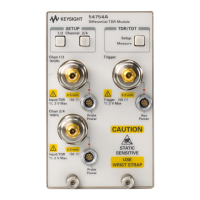Improving Time Domain Network Measurements
Removing Measurement Errors
10-17
(2)
where : a
0
+ a
1
+ a
2
+ a
3
= 1
L = the full width of the window in hertz
f = frequency in hertz
A window of this form may be selected that rolls off quickly and has an almost
Gaussian impulse response. The impulse response of the window defines the
ideal response. The Gaussian response is considered ideal because it has a
minimum settling time after a transition from one voltage level to another.
Minimizing the settling time minimizes the interference between closely-spaced
discontinuities, thus making them easier to see and analyze. The filter's
bandwidth, and therefore risetime, is determined by the choice of L, the width
of the sum of the cosines window. The actual normalization filter, F(f), is
computed by dividing the sum of cosines window by the frequency response of
the test system, S(f) (see equation 3). The frequency response is the Fourier
transform of the impulse response.
(3)
By varying the bandwidth of the filter, normalization can predict how the DUT
would respond to ideal steps of various risetimes. The bandwidth of the test
system is the frequency at which the frequency response is attenuated by 3 dB.
The response beyond the cutoff frequency is not zero; it is only attenuated
(Figure 10-13). By carefully changing the - 3 dB point in the frequency
response, the bandwidth can be increased or decreased.
Wf() a
k
2πfk
L
-----------
for
L–
2
------
f
L
2
---
<<
,cos
k
0=
3
∑
=
Ff()
Wf()
Sf()
-----------=

